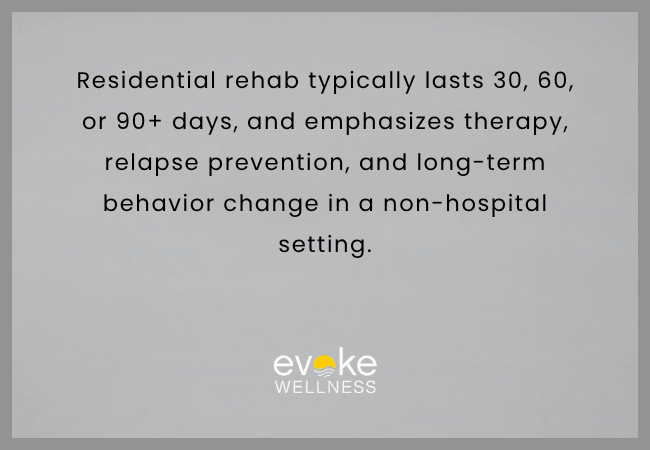When facing the complex challenges of addiction or mental health conditions, choosing the right level of care is one of the most important decisions a person can make. Among the most common types of care are inpatient rehab and residential rehab. While these two terms are often used interchangeably, they offer different experiences and levels of intensity. Understanding the differences can be crucial in determining which path offers the best chance for sustainable recovery.
At Evoke Wellness at Hilliard, we understand that healing is not one-size-fits-all. Each individual who walks through our doors brings a unique story, unique needs, and their own goals for sobriety and wellness. Choosing between inpatient and residential care is part of creating a recovery plan that aligns with those personal circumstances. Let’s explore what makes these two forms of treatment different—and why those differences matter more than you might think.
Understanding Inpatient Rehab
Inpatient rehab is typically associated with a more acute level of care. This kind of treatment is often provided in a hospital-like environment, especially when medical oversight is necessary. Inpatient programs are usually short-term, lasting anywhere from a few days to a few weeks, and are designed to stabilize individuals in crisis.
People may enter inpatient rehab during moments of severe withdrawal symptoms, psychiatric emergencies, or following a relapse that requires immediate intervention. The environment is highly structured, with constant supervision, clinical interventions, and access to medical staff. The focus during inpatient treatment is immediate safety, medical stabilization, and the prevention of harm.
Because inpatient care focuses so heavily on urgent needs, there is typically less emphasis on long-term therapy, peer support, or life skill development. Once stabilized, patients are usually transitioned to a less intensive level of care to continue their recovery.
Understanding Residential Rehab
Residential rehab, on the other hand, is designed for people who have moved past the most acute stages of withdrawal or crisis but still require a highly structured and immersive therapeutic environment. This form of treatment is more holistic and tends to focus on the underlying causes of addiction, behavioral change, emotional healing, and the development of coping skills.
Clients in a residential setting live at the facility for an extended period—usually 30, 60, or 90 days—depending on their individual needs and progress. They participate in a range of therapies including individual counseling, group therapy, family therapy, recreational activities, and often trauma-informed care. Unlike a hospital setting, residential programs tend to feel more like a community, which can foster a stronger sense of connection and support.
One of the biggest benefits of choosing a Residential Treatment Center in Ohio like Evoke Wellness at Hilliard is the opportunity to recover in a stable, safe, and recovery-focused environment. Residential rehab addresses not just physical sobriety but emotional wellness and mental clarity, preparing clients for life beyond treatment.
Key Differences: A Closer Look
1. Environment and Comfort
Inpatient rehab often takes place in clinical settings where the primary concern is medical safety. These environments are functional and secure, but they can sometimes feel sterile or impersonal.
Residential rehab, in contrast, tends to provide more home-like surroundings. Comfortable living quarters, communal spaces, and serene surroundings can help clients feel more at ease and emotionally open to the therapeutic process. This difference can significantly impact one’s willingness to engage in treatment and explore difficult emotional work.
2. Length of Stay
Inpatient programs are generally shorter, serving as a bridge to long-term care or as crisis intervention. Once stabilization is achieved, clients are moved to another level of care.
Residential programs are longer in duration, allowing more time for emotional healing, skill-building, and relapse prevention. The extended stay is especially beneficial for those with long-standing addiction histories or co-occurring conditions.
3. Therapeutic Intensity
In inpatient care, the focus is typically on managing symptoms and stabilizing health, which means therapeutic sessions may be limited.
Residential programs offer a broader and more consistent therapeutic schedule. Clients receive comprehensive services, which may include trauma therapy, cognitive-behavioral therapy, mindfulness training, and life skills coaching. This allows for deep, meaningful change.
4. Focus on Long-Term Recovery
Inpatient rehab is often the first step—urgent, necessary, but not sufficient for long-term recovery. Residential rehab picks up where inpatient leaves off, helping clients build the emotional resilience and practical tools needed to remain sober and well after discharge.
At Evoke Wellness at Hilliard, we integrate a full continuum of care that includes both inpatient and residential options, recognizing that each plays a critical role in the recovery journey.
Treating Co-Occurring Disorders
For individuals struggling with both substance use and mental health challenges, known as dual diagnosis, choosing the right type of rehab becomes even more crucial. While both inpatient and residential settings can offer psychiatric support, residential programs are often better suited for ongoing dual diagnosis care. A Dual Diagnosis Treatment Program in Ohio like ours ensures that both conditions are treated simultaneously with an integrated approach, increasing the likelihood of long-term recovery.

Choosing Care Based on Need, Not Labels
It’s important to remember that choosing between inpatient and residential care should not be about semantics but about clinical necessity. An individual’s choice should be based on their current mental and physical health status, addiction severity, support system, and history of relapse. Clinicians and admissions teams can help assess these factors and recommend the most appropriate level of care.
Sometimes, a person may start with inpatient treatment for medical stabilization and then transition into residential rehab. Other times, individuals can enter directly into residential care, especially if detox or medical supervision is not required.
The point is not which one is “better,” but which one is better for you at this moment.
The Role of Mental Health in Treatment
Many individuals seeking help for addiction also face unresolved trauma, anxiety, depression, or other psychiatric conditions. Treating these conditions alongside addiction is not optional—it’s essential. A comprehensive Mental Health Treatment Center in Ohio will offer therapeutic programs designed to heal both body and mind. Without this integrated approach, one condition can often trigger relapse in the other.
Residential rehab settings are uniquely positioned to handle this complexity. They offer consistency, routine, and enough time for individuals to address and manage their mental health with the support of licensed professionals.
Bridging Treatment and Real Life
One of the strengths of residential care is its emphasis on preparing clients for life after treatment. From relapse prevention plans to vocational training, and from family therapy to alumni support, residential programs focus on long-term sustainability.
This level of preparation is especially critical for those stepping down from a more clinical Intensive Inpatient Treatment Program in Ohio. The transition between levels of care is not just about physical relocation—it’s about emotional readiness and practical planning.
Why Choose Us?
At Evoke Wellness at Hilliard, we take pride in offering comprehensive Addiction Treatment Programs in Ohio that are individualized, evidence-based, and built around the needs of the whole person. We believe that recovery is a personal journey that requires compassion, expertise, and continuity of care. Whether you need medical stabilization, deep emotional healing, or help developing life skills, our team is here to walk with you—every step of the way.
Conclusion
Understanding the difference between inpatient and residential rehab is more than just clarifying terminology—it’s about knowing what kind of help is right for you or your loved one. Inpatient care offers immediate safety and medical support, while residential rehab provides the time, space, and therapeutic depth needed for lasting change.
By recognizing these distinctions and choosing the most appropriate path, individuals are far more likely to achieve meaningful, sustainable recovery. At Evoke Wellness at Hilliard, our focus is on transforming lives—not just in the moment, but for the long haul.
Frequently Asked Questions (FAQs)
What is the main difference between inpatient and residential rehab?
The primary difference lies in intensity and setting. Inpatient rehab is hospital-based and focuses on acute medical stabilization, while residential rehab provides longer-term therapeutic care in a home-like environment.
How do I know if I need inpatient or residential treatment?
A clinical assessment by a licensed professional can help determine the best level of care. Generally, inpatient treatment is for those in crisis or active withdrawal, while residential rehab suits those needing structured, ongoing support after stabilization.
Is residential rehab more effective than inpatient care?
Each has a purpose. Inpatient care is crucial for immediate safety and stabilization, while residential rehab is more effective for long-term healing, behavioral change, and relapse prevention.
Does residential rehab treat co-occurring disorders?
Yes. Many residential programs offer integrated care for individuals with both mental health and substance use disorders, often referred to as dual diagnosis treatment.
What does a typical day look like in residential rehab?
A typical day includes individual therapy, group counseling, recreational activities, wellness practices, and time for reflection. The structure helps promote stability and healing.



